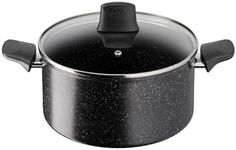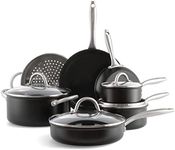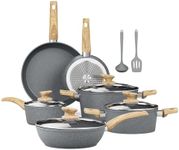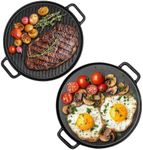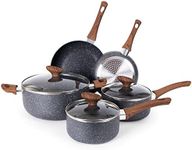Buying Guide for the Best Pots And Pans
Choosing the right pots and pans can significantly enhance your cooking experience. The right cookware can make a difference in how your food cooks, how easy it is to clean, and how long it lasts. When selecting pots and pans, consider your cooking habits, the types of dishes you frequently prepare, and your personal preferences for materials and features. Here are some key specifications to consider when making your choice.MaterialThe material of pots and pans affects heat conductivity, durability, and ease of cleaning. Common materials include stainless steel, non-stick, cast iron, and copper. Stainless steel is durable and resistant to rust, making it a good all-around choice. Non-stick pans are great for low-fat cooking and easy cleaning but may not last as long. Cast iron retains heat well and is excellent for searing but requires more maintenance. Copper offers superior heat conductivity but can be expensive and requires regular polishing. Choose a material based on your cooking style and maintenance preferences.
SizeThe size of pots and pans determines how much food you can cook at once. Sizes range from small saucepans to large stockpots. Smaller pans are ideal for single servings or small dishes, while larger pots are better for family meals or batch cooking. Consider the number of people you typically cook for and the types of dishes you prepare. If you often cook large meals, a set with a variety of sizes will be beneficial.
WeightThe weight of cookware can impact ease of use and cooking performance. Heavier pots and pans, like those made from cast iron, provide even heat distribution and are great for slow cooking. However, they can be difficult to handle and clean. Lighter cookware, such as aluminum or non-stick, is easier to maneuver but may not offer the same heat retention. Choose a weight that you are comfortable handling, especially if you have any physical limitations.
Handle DesignHandles can affect the comfort and safety of using pots and pans. Look for handles that are securely attached and comfortable to grip. Some handles are designed to stay cool during cooking, which can prevent burns. Others may have ergonomic designs for better control. Consider how the handle feels in your hand and whether it provides a secure grip, especially when the pan is full.
Compatibility with CooktopsNot all pots and pans are compatible with every type of cooktop. Common cooktops include gas, electric, and induction. Induction cooktops require cookware with magnetic properties, such as stainless steel or cast iron. Gas and electric cooktops are more versatile but may require flat-bottomed pans for even heating. Ensure that the cookware you choose is suitable for your cooktop to avoid any issues with cooking performance.
Oven-SafeSome recipes require transferring cookware from the stovetop to the oven. Oven-safe pots and pans can withstand high temperatures without damage. Check the maximum oven-safe temperature of the cookware, which is usually indicated on the packaging or manufacturer's website. If you frequently bake or roast, choose pots and pans that can go from stovetop to oven seamlessly.
Ease of CleaningCleaning can be a major factor in choosing cookware. Non-stick pans are generally easier to clean but may require gentle handling to avoid damaging the coating. Stainless steel and cast iron can be more challenging to clean but offer greater durability. Some cookware is dishwasher safe, which can save time and effort. Consider your cleaning preferences and choose pots and pans that align with your desired level of maintenance.

